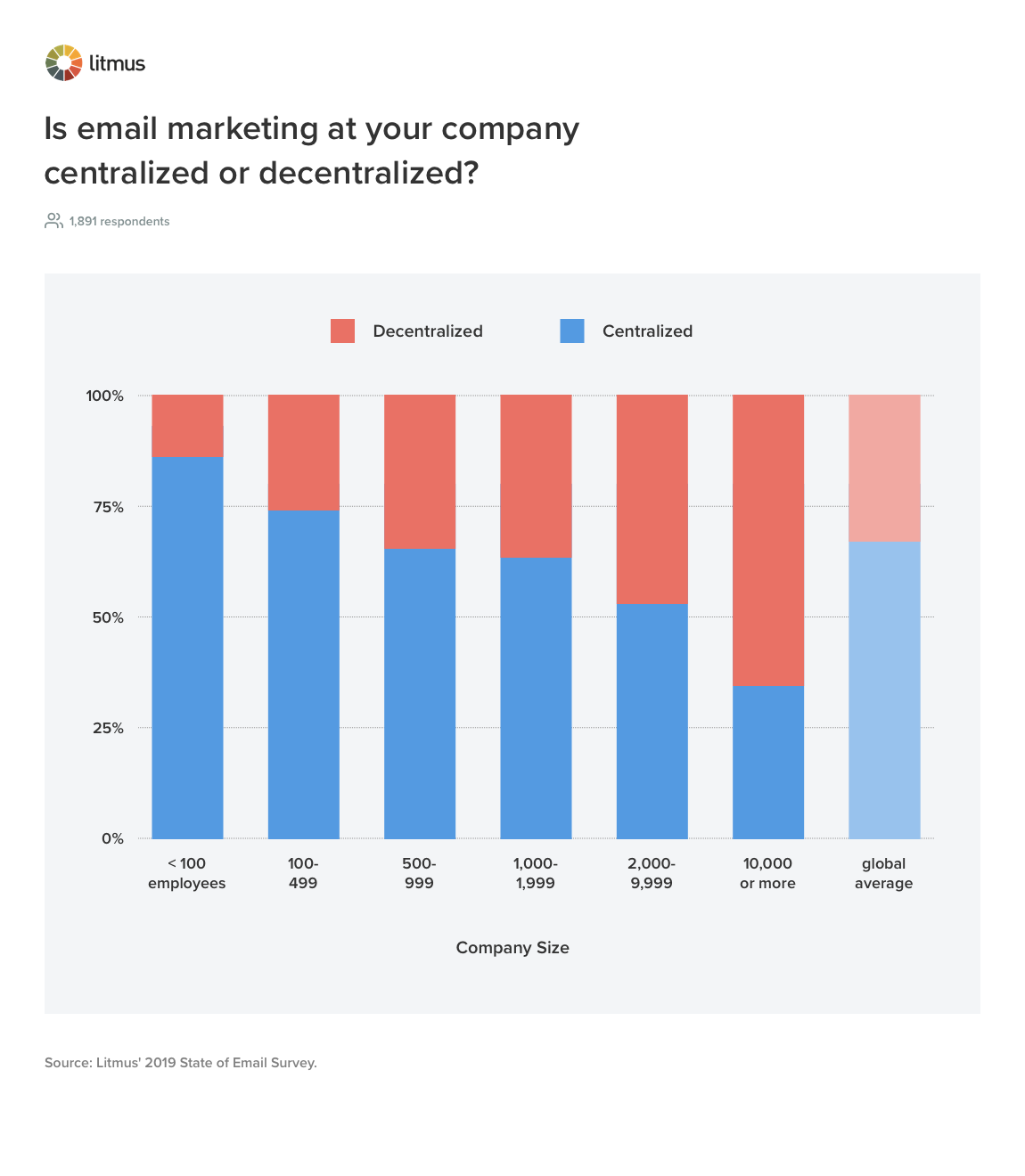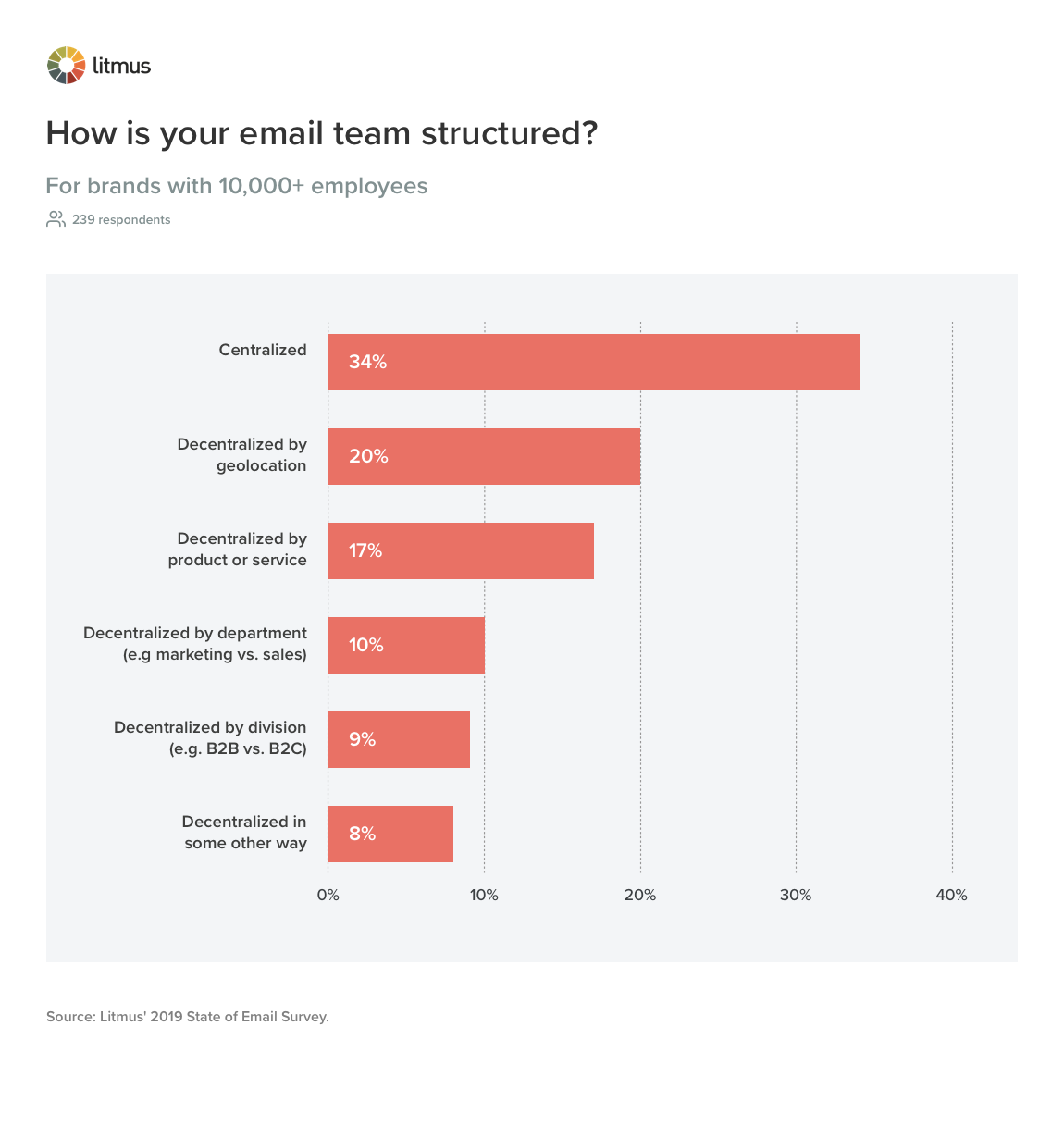Organizing Email Teams: Centralized vs. Decentralized Team Structures
You’re bound to have some growing pains when expanding your email marketing program. When your company grows, so more and more teams turn to you for email support and you’re asked to deliver an increasing number of campaigns, your email team will grow too. But how do you structure your team for long-term success?
Deciding how to organize the team in the grand scheme of your company and all its segments is a big decision—and it can affect your process for years to come.
The two main email team structures you’ll need to choose between are centralized versus decentralized. But what exactly does that mean?
Centralized teams are a core group with a united front that serves multiple business functions, geographies, or products.
Decentralized teams take a divide and conquer strategy, with different countries or products building separate teams and unique campaigns.
But how do you know which team structure is the right one for your brand?
Pros and Cons of a Centralized Email Team
One of the main advantages of a centralized email organization is practically in the name. When all of the strategy, writing, and designing comes from the same group, you end up with more cohesive campaigns across segments. When done right, a centralized email organization can also be a well-oiled machine, creating a repeatable process that utilizes different team members’ strengths.
On the other hand, centralized teams can become too large. Keeping team members within a specific lane of work can hinder creativity and experimentation. The more people involved in the process of a single email, the longer the process can take. 23% of marketers find their email approval process too burdensome because of how many people are involved. On average, marketers spend 3.9 hours managing email reviews and securing approval.
Pros and Cons of a Decentralized Email Team
Since decentralized marketing organizations are broken up into smaller units, teams can be more agile and more focused on the needs of their unique customers. Campaigns across the world or between different customer segments will feel more relevant to the end-user when decentralized employees are empowered to make decisions. Smaller groups also mean that approvals can happen faster—and organizations are more likely to be able to A/B test new ideas.
While decentralized teams can deliver hyper-relevant emails to subscribers, there’s a chance the company and brand as a whole will become fragmented. Standards for messaging, branding, and strategy can be harder to enforce when you have teams operating independently—and with that comes the risk of an inconsistent subscriber experience.
Which email team structure should you choose?
Both centralized and decentralized email teams come with pros and cons, so how do you know which is best? Frustratingly, the answer is “it depends.” Luckily, we have data to help you sort out the decision.
We polled marketers at companies of all sizes about how their teams are organized. In general, companies across the world prefer a centralized structure, with 67% using this method. Decentralized email teams make up the other 33%.

Here are a few more insights we found:
If your company is small, choose centralized
A staggering 86% of companies with less than 100 employees opt for a centralized email team. This makes sense because there likely aren’t enough email employees at that stage to spread them across many different segments. When there are less than 100 employees total in the company, it’s also likely that the entire email team is able to work reasonably quickly.
Medium-sized companies have options
What’s the “breaking point” where a centralized team becomes too big to manage as one unit? According to our research, having a centralized team didn’t fall out of the majority until you get to companies with 10,000 or more employees. Team structure was less clear cut with medium-sized companies, though.
Centralized teams are still favored by companies with 500-999 and 1,000-1,999 employees, with 65% and 63% of organizations, respectively, keeping it all together. But this range of company sizes is where the data starts to lean towards decentralization.
Whether a medium-sized company should opt for a centralized or decentralized email team structure depends heavily on how your business is organized. Does your entire organization serve a similar customer base? If so, a centralized marketing organization can help keep the subscriber experience consistent. However, if you have strong and distinctive business units that serve unique markets, customer segments, or geolocations, a decentralized organization can help your email team be closer to their audiences and deliver more relevant campaigns.
Decentralized reigns supreme in large companies
Unsurprisingly, companies with 10,000 or more employees choose decentralized marketing teams the majority of the time. Grouping email organizations by geography is the most popular decentralization method, with 20% of the largest companies opting for it.

Having different email marketers own different products or services within a company is another choice for large teams. 12% of companies with 2,000-9,999 employees choose this method, and 17% of the 10,000+ employee companies do the same. Another way mega-companies split up email include by division, such as B2B and B2C, which is reported by 9% of companies.
 | How Litmus helps decentralized teams send great emailsMINDBODY’s email program is heavily decentralized, with multiple teams responsible for their own campaigns. With the Litmus at the center of the email creation process, the team ensures a consistently great subscriber experience for all of MINDBODY’s emails. |
Curious how Litmus can help your brand send consistently great emails, no matter how your team is organized? Talk to a Litmus expert to learn more.
Find the organizational structure that’s right for you
33% of email teams plan to spend more on personnel in the coming year, and they’ll have to decide how to organize these new employees. When deciding what’s best for your organization, consider your company size, structure, and strategy. Clear distinctions between product lines, customer categories, or countries lend themselves to decentralized teams. As the company grows, so too does the likelihood that a centralized team will be too big to manage efficiently. For teams at smaller companies that want to stick with a centralized email team, you should review your email approval process for speed.
Streamline your email review process with Litmus ProofWith Proof as your centralized tool for collecting feedback, you can improve collaboration, get better visibility, and cut review cycles. |

Brooke Freedman
Brooke Freedman was the Senior Director, Sales at Litmus
